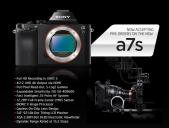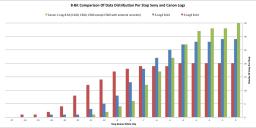
-
Let's wait for real tests, i mean when it will be in our hands...
-
The A7s has been officially priced at $2500...
Will be available in July.
Preorder links
-
Like predicted. Sony is very predictable company.
-
Can be popular, we'll see some reviews first. E mount and mirorrless form factor are much more handy compared to any Canon.
-
Have you guys seen the promo claiming 15.3 stops of dynamic range? Bottom line. Stills mode? Video? I mean if some of that can be translated to the S-Log 2 this is the camera of my dreams!!! Even if we can get 13 stops in video I would be happy! As good as the highest dollar one can pay for a mid range cine camera. For 2 grand. RED should have sold a camera like this in this price point and they would have 'ruled' the world of affordable cinema at the high end and the low but the whole 'man up' attitude and pay the price of a car made them miss folk like me who are chomping at the bit for this camera. I was sooooooo happy with the Scarlet that was 3k for 3k. I am afraid I cannot see them lasting past a few more years if Sony keeps upping the ante by improving this beast of a sensor gradually - they will put it in a bigger body like the F5, add ins and outs, RAW - undercut RED and boom - just like that RED becomes even more a niche. On paper this camera will most likely get BBC certification which for any indie content maker may be HUGE!!!!! Whatever happens - thank you SONY!!!!!Today is a good day!

 A7S.jpg650 x 492 - 91K
A7S.jpg650 x 492 - 91K -
^ DXomark measured RED Dragon 14.8 EV, Nikon D800 14.4 EV.
-
but doesn't full frame mean SEL lenses from NEX or FS series won't cover the sensor? Then add some bucks for lenses..
-
if you own already some, yes. But if you ever had benefit from IS / OSS and auto focus you will miss it. At least I do as I do some run & gun sometimes.
-
@peaceonearth The Metabones active EF adapter will give you IS ability with Canon lenses. The AF speed will be either slow or nonexistent, depending on lens, but you do not use AF much with video.
-
but you do not use AF much with video.
maybe you don't. I have to admit that I used the FS700 quite often with the SEL 18-200 and SEL 10-18. As I said for run & gun, documentaries and for almost all handheld shots. It works pretty well. I am sure I would have lost many more shots with manual focus than I had with slow or mistaken AF
-
The a7S has APS-C crop modes for both stills and video. Those same Sony APS-C E-mount lenses for the FS700 will work on the a7S, though not with full 12 megapixel or 4k resolution.
Here's a little secret, and I'm only exaggerating slightly: the only difference between a cheap old lens and an expensive old lens is how well they perform at wide apertures. Stop down a bit, and the cheap lens becomes an excellent performer. If you don't need super shallow depth of field and your camera has good low light performance, those cheap old lenses become great options.
-
I was set on buying a GH4 to replace my GH2. Now I'm thinking the A7s may be the better investment.
As far as I can tell, it comes down to this:
*GH4 gives internal 4K, possibly a sharper image, a stronger All-I codec, and a smaller sensor (good for using my Speedbooster and the APS-C glass I already own).
*A7s gives much more dynamic range, insanely much better ISO performance, and a bigger sensor (good for using my old Nikon AI/AI-s lenses).
I don't particularly care about sensor size, beyond what it means about my lens choices. I would miss my Sigma 18-35, and I do quite enjoy using the Speedbooster, but overall it's probably an upgrade moving to full frame. I really like vintage 35mm lenses, and being able to use them at their intended FOV is a nice idea.
4K would be nice to have, but I don't need it yet. With the A7s I can continue shooting 1080p for the time being, and when I feel compelled to make the jump I can buy an add-on HDMI recorder. It's a significant added expense, but on the other hand the 4:2:2 uncompressed 4K from the A7s will probably blow the GH4 out of the water so it'll be a meaningful upgrade beyond just "catching up" with the GH4.
What I do care about is dynamic range, and having a decent codec. 50Mbps is a little low for modern cameras, but I sincerely doubt that Sony would cripple this camera after obviously investing so much in other well thought-out video features. It's probably a very optimized 50Mbps, and with the S-log curve and 15.6 stops of dynamic range, I don't think I'll be pushing the image very far in post. More likely I'll just be crushing the blacks, upping the saturation, and adding a little creative tonality to the colors, which any modern codec should handle just fine. Where codecs fall apart in my experience is when you try to boost exposure in post, reduce contrast, or recover highlights. With the specs on the A7s, none of those things should ever be necessary.
The dynamic range of the A7s... that's what really blows me away here. Here I was thinking that wide DR would continue to be the province of Blackmagic, while DSLRs and mirrorless cameras from the larger companies would stay under 12 for the indefinite future. 15.6 stops is phenomenal.
That, and the ISO performance. Watch this video:
As absurd as it sounds, you could shoot night for day. Or you could stop down and shoot deep DOF in dimly lit interiors. I think the big news isn't so much that this camera can shoot 400,000 ISO, but that it can shoot 20,000 ISO with very little noise. It may be the perfect run-and-gun documentary camera, coupled with a power-zoom image stabilized lens.
-
According to Amazon info it's 15.3 stops. But if it's a useable 12 stops in video mode that would be pretty phenomenal. The price is high for me, but if I see more outstanding video demos from this camera I might be swayed. The extra money spent on the camera could be made up by buying vintage full-frame lenses. I'm looking forward to more examples.
-
S-log2 has a precisely defined transfer function and a corresponding S-gamut. They should be the same on every camera that uses them. Sony had a choice to use S-log1, S-log2, or S-log3 for dynamic ranges of different sizes.
The attached chart shows the distribution of codes over the dynamic range. Source: cameramanben (Ben Turley) at http://community.sony.com/t5/F5-F55/S-Log3-vs-S-Log2/td-p/282689/page/8
S-log2's S-gamut isn't just an expanded rec.709 gamut. It's shifted in CIE xy space. You can't convert from S-gamut to rec.709 just by boosting the saturation. You need a LUT or a matrix transform. It would be nice if the camera would let you select the gamut independently from the transfer function, as other Sony cameras do.
Some people will say that 8 bits isn't enough precision for such a large dynamic range. But from my testing, it's not a problem. Compression artifacts are a much bigger problem. I'm hopeful that XAVC-S's 50 Mbps long-GOP h.264 will be sufficient given the camera's low noise at low and moderate ISO settings. But uncompressed external recording is always another option.

 S-log2 8-bit dynamic range.jpg1174 x 573 - 96K
S-log2 8-bit dynamic range.jpg1174 x 573 - 96K -
Not S-log2, just similar high dynamic range log footage from other cameras. Canon C-log in 8 bits is really the closest thing to 8-bit S-log2 and you'll see there are lots of people using it without problems. People complained about 8-bit S-log2 recording in the Sony FS700, but I think that is more about the low bit rate than the color precision - just 25 Mbps. 50 Mbps is a huge improvement. Tell me the Arbroath Smokies video doesn't look good to you. It was all done in S-log2 with internal recording. I'm not saying that 8 bits will never pose a problem, but it's not the automatic failure that some people make it out to be.
Howdy, Stranger!
It looks like you're new here. If you want to get involved, click one of these buttons!
Categories
- Topics List24,098
- Blog5,725
- General and News1,403
- Hacks and Patches1,153
- ↳ Top Settings33
- ↳ Beginners256
- ↳ Archives402
- ↳ Hacks News and Development56
- Cameras2,401
- ↳ Panasonic995
- ↳ Canon118
- ↳ Sony156
- ↳ Nikon96
- ↳ Pentax and Samsung70
- ↳ Olympus and Fujifilm102
- ↳ Compacts and Camcorders300
- ↳ Smartphones for video97
- ↳ Pro Video Cameras191
- ↳ BlackMagic and other raw cameras149
- Skill1,960
- ↳ Business and distribution66
- ↳ Preparation, scripts and legal38
- ↳ Art149
- ↳ Import, Convert, Exporting291
- ↳ Editors191
- ↳ Effects and stunts115
- ↳ Color grading197
- ↳ Sound and Music280
- ↳ Lighting96
- ↳ Software and storage tips266
- Gear5,420
- ↳ Filters, Adapters, Matte boxes344
- ↳ Lenses1,582
- ↳ Follow focus and gears93
- ↳ Sound499
- ↳ Lighting gear314
- ↳ Camera movement230
- ↳ Gimbals and copters302
- ↳ Rigs and related stuff273
- ↳ Power solutions83
- ↳ Monitors and viewfinders340
- ↳ Tripods and fluid heads139
- ↳ Storage286
- ↳ Computers and studio gear560
- ↳ VR and 3D248
- Showcase1,859
- Marketplace2,834
- Offtopic1,343
Tags in Topic
- sony 252







